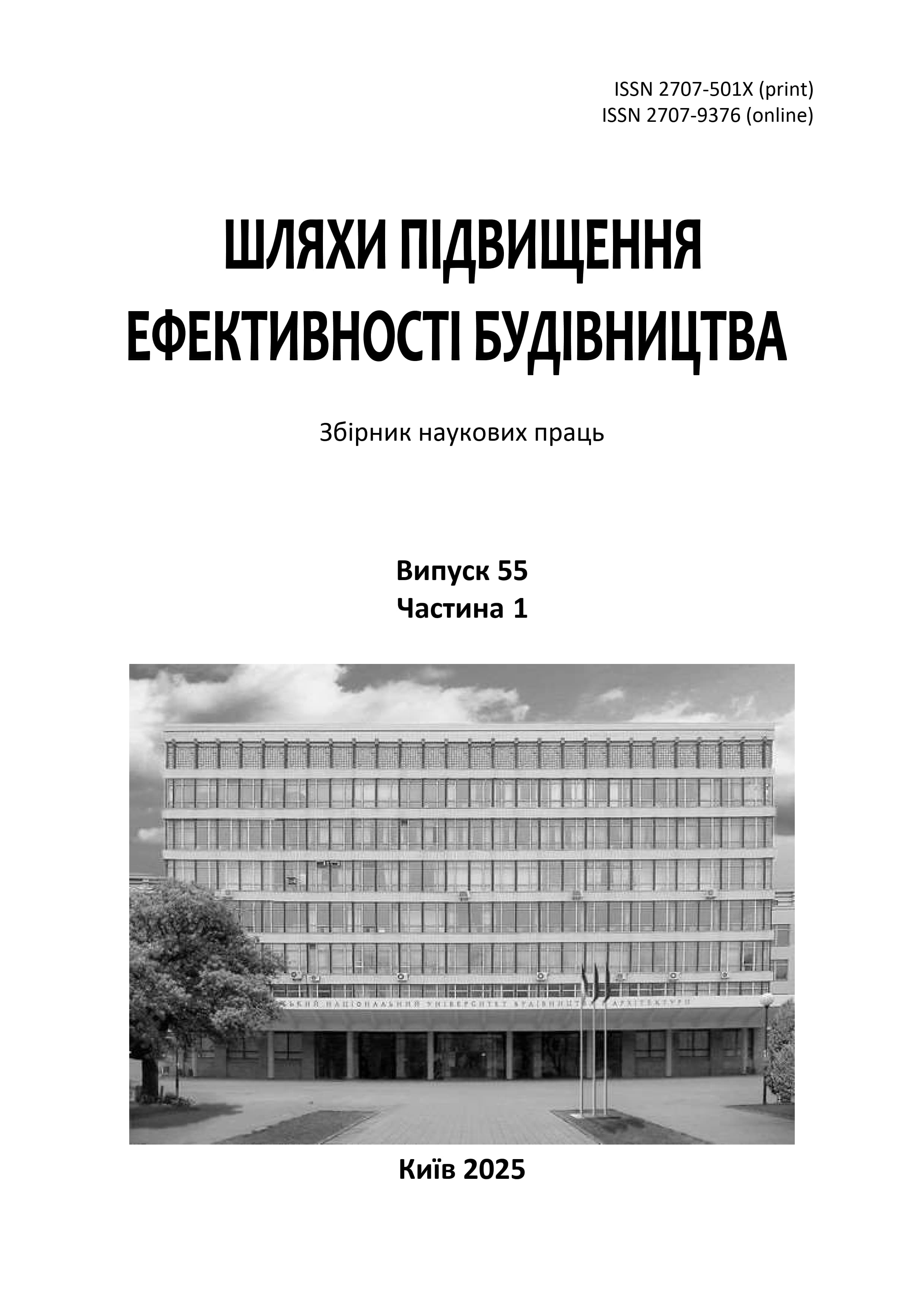Analytical and theoretical aspects of the influence of IT technologies in the context of optimization of the organization of construction processes
DOI:
https://doi.org/10.32347/2707-501x.2025.55(1).40-47Keywords:
organization, construction, optimization, construction management, innovative technologies, provisionAbstract
The main purpose of this article is to study the analytical and theoretical aspects of the impact of IT technologies on the optimization of the organization of construction processes. The theoretical foundations and practical aspects of the use of information technologies to optimize organizational processes in construction are investigated. In particular, this study focuses on the analysis of opportunities and advantages provided by IT technologies to improve the coordination of work, resource management, planning and control over the implementation of construction projects. The prospects for the use of IT technologies in construction are substantiated, which contributes to the optimization of organizational processes, improving interaction between project participants and reducing the risks of errors. Automation of planning and resource management allows you to reduce costs and increase the efficiency of management decisions. Thanks to such technologies, greater transparency, quality control and safety are ensured. Therefore, the possibilities and practical application of modern IT technologies in the construction industry are relevant and necessary. It allows not only to assess their impact on the efficiency and quality of work, but also contributes to the formation of new approaches to the implementation of construction projects in the context of global technological changes. The specifics of organizational processes require a significant revision of the concepts and operating principles of optimization models of construction production. The study focuses on the development and formalization of a digital platform for algorithmic-criterion modeling of parametric optimization of organizational processes in construction. The proposed approach is aimed at systematizing and improving the mechanisms of coordination of intersectoral interaction, which contributes to the effective use of the material and technical base of the domestic market. The proposed concept is based on analytical, theoretical and methodological approaches to the systematization of a complex multicomponent system, using a digital platform that ensures consistency between project time indicators, material flows and cost parameters, as well as contributes to the automation of organizational and technological processes and the introduction of intelligent resource monitoring systems
References
Алієв Р.Ш. Інформаційні технології у будівництві: навчальний посібник. Київ: Видавництво КПІ ім. Ігоря Сікорського, 2020. 256 с.
Бондар О. А., Поколенко В. О., Пилипчук О. Д., Халілов А. Аналітичний базис діяльності підрядного підприємства в сучасному цифровому середовищі. Шляхи підвищення ефективності будівництва в умовах формування ринкових відносин. Вип. 47, т. 1. 2021. С. 87–95. DOI:10.32347/2707-501x.2021.47(1).87-95
Беркута А., Осінська В., Галинський О., Вахович І. Організаційні та економічні аспекти зарубіжного досвіду саморегулювання в будівництві. Будівельне виробництво. 2010. № 52. С. 3-8.
Гоц В.В. Інтегроване управління інформаційним середовищем девелоперських проектів: автореф. дис. ... к-та. техн. наук: 05.13.22. Київ: КНУБА, 2014. 25 с.
ДБН А.3.1-5-2016 Організація будівельного виробництва [Чинний від 1.01.2016]. Київ: Мінрегіонбуд України, 2016. 49 с.
Зайченко Ю.П. Розвиток цифрової економіки в будівельній сфері. Економіка і управління. 2021. №2. С. 45–52.
Омельяненко М., Омельяненко М. Інформаційна модель об’єкта нормування як основа визначення нормативних вимог із застосуванням параметричного методу нормування. Сучасні проблеми архітектури та містобудування. 2020. № 58. С. 233−247. DOI: https://doi.org/10.32347/2077-3455.2020.58.233-247 .
Підгурська І.О. Робототехніка у будівництві: перспективи розвитку. Інноваційні рішення в будівництві. 2021. №1. С. 65–72.
Організація та управління будівництвом: підручник / О.А. Тугай та ін. Київ: Ліра-К, 2024. 400 с.
Arutiunian I., Radkevic A., Kuznetsov V., Kovalenk M., Skrzyniarz M. Setting Dynamic Problem of Logistic Support of Building Objects by Material Resources Taking into Account Random Factors Affecting Transportation Timing. Transport Means 2021.Proceedings of 25th International Scientific Conference. 2021. № 111. P. 1080-1084. URL: https://transportmeans.ktu.edu/wp-content/uploads/sites/307/2018/02/Transport-Means-2021-Part-III.pdf.
Ivanov, A., & Petrov, V. (2020). Smart Construction: Integrating IoT and AI for Sustainable Development. Journal of Civil Engineering and Management, 26(4), 345-360.
Taylor, R. (2021). Artificial Intelligence in Modern Construction. Building Innovation Journal, 18(3), 142-156.
Wong, K., & Fan, Q. (2020). Big Data Analytics in Construction: Applications and Challenges. Engineering Science Review, 22(1), 98-115.
Zhou, L. (2021). IoT in Construction: Revolutionizing Resource Management. Smart Infrastructure Journal, 12(4), 209-223
Downloads
Published
How to Cite
Issue
Section
License

This work is licensed under a Creative Commons Attribution 4.0 International License.
Authors who publish with this journal agree to the following terms:
- Authors retain copyright and grant the journal right of first publication with the work simultaneously licensed under a Creative Commons Attribution License that allows others to share the work with an acknowledgement of the work's authorship and initial publication in this journal.
- Authors are able to enter into separate, additional contractual arrangements for the non-exclusive distribution of the journal's published version of the work (e.g., post it to an institutional repository or publish it in a book), with an acknowledgement of its initial publication in this journal.
- Authors are permitted and encouraged to post their work online (e.g., in institutional repositories or on their website) prior to and during the submission process, as it can lead to productive exchanges, as well as earlier and greater citation of published work (See The Effect of Open Access).

